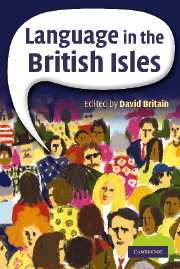Book contents
- Frontmatter
- Contents
- List of figures
- List of tables
- List of contributors
- Acknowledgements
- Map of the British Isles
- Introduction
- Part I English
- Part II The Celtic Languages
- 11 The history of the Celtic languages in the British Isles
- 12 Gaelic
- 13 Irish
- 14 Welsh
- Part III The Other Languages of the British Isles
- Part IV Applied Sociolinguistic Issues
- References
- Index
11 - The history of the Celtic languages in the British Isles
Published online by Cambridge University Press: 16 January 2010
- Frontmatter
- Contents
- List of figures
- List of tables
- List of contributors
- Acknowledgements
- Map of the British Isles
- Introduction
- Part I English
- Part II The Celtic Languages
- 11 The history of the Celtic languages in the British Isles
- 12 Gaelic
- 13 Irish
- 14 Welsh
- Part III The Other Languages of the British Isles
- Part IV Applied Sociolinguistic Issues
- References
- Index
Summary
When in 55 BC the standard-bearer of the tenth legion leapt into the sea at Richborough and led Caesar's forces ashore onto British soil, not only did he bring permanent social and political change to Britain but also enormous linguistic change to the speakers of Celtic languages in the British Isles. Like all defining moments it is easy to make too much of them; for not only had contact between Britain and Rome been ongoing for many years before Caesar landed in Britain, but at this stage the Romans did not stay; they reappeared briefly in the following year and then it was not until AD 43 under Claudius that the Romans made their presence in Britain permanent. Nevertheless, it provides one of a number of useful staging points from which to survey the history of the Celtic languages in the British Isles. This one is, however, particularly significant as it is the point at which Britain entered the Roman world where it was to remain for the next five centuries; and the influence of Rome was to be much longer lasting than that.
This will be the format of the first part of this chapter: a tour of the British Isles pausing at key points both historical and geographical from which we may consider the development of the Celtic languages. The second part of the chapter then goes on to examine a number of features of the Celtic languages in greater detail.
- Type
- Chapter
- Information
- Language in the British Isles , pp. 185 - 199Publisher: Cambridge University PressPrint publication year: 2007

